It was now twenty-one days since he left the nest and he was moving further away from the nest. However, his parents were still feeding him and would do this until the age of 48 days. But he was different, and proved this by catching small invertebrates at the tender age of 30 days. “Quite an achievement for such a young bird”, he overheard the adults whisper. Some said he was advanced for his age, but most of them thought he was arrogant and a danger to the status quo of the colony.
At the time of his first flight he realised that all three his siblings had died. He later found that it was very rare for a Sacred Ibis chick to make it beyond 30 days. Breeding success is generally low, with an average of 0.01 young fledgling per nest. Much later in his life he would find that only his third female was successful in raising a chick to fledgling status. He made it all the way to this stage. He was one in a hundred. Life was precious indeed.
When he started flying, a new world opened up to him. He realised that the colony was about 300 strong and shared its resources with other birds like the Spoonbills and the odd Grey Heron (Ardea cinerea). Quite a majestic creature, that one. And to top it, he had an unnervingly high success rate in frog catching. He admired this bird. He was now a mature bird, measuring about 76cm in length with long legs and a thin downward-curved beak which he used to look for food in the shallow water of the swamp. He had white feathers covering most of his body and black plumes on its lower back. His head and neck were featherless and covered in a black scaly skin.
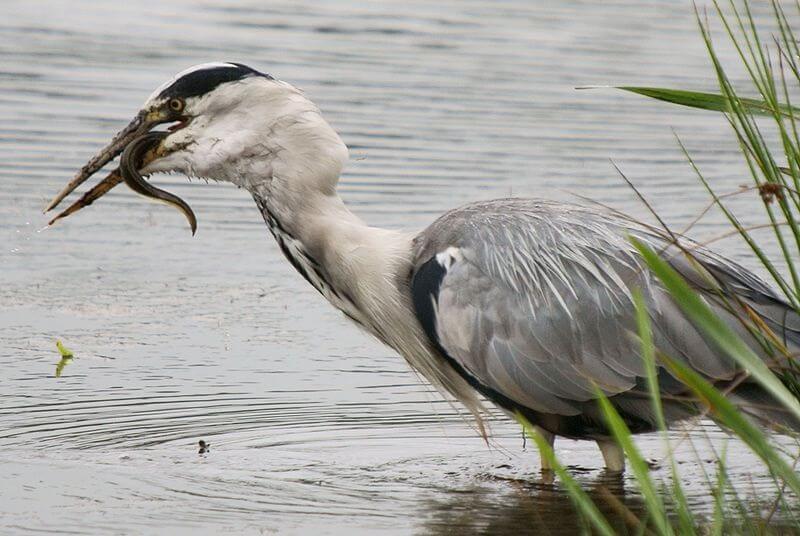
It was around the time of his 60day birthday when the restlessness in him started. He wanted to explore. Break away from the colony and fly off into the unknown. His problem was that none of the colony birds were interested in joining him. He befriended another male and female and would often go on reconnaissance outings with them. Every so often he would increase the flying time by a few minutes, until one day they stayed away for almost 6 hours. In his own mind he was ready to break away.
Then one morning, without prior consideration and zero planning, he took off and disappeared over the horizon, never to be seen again by his colony. The day was 14 June 2004, a typical cold and rainy winter’s day in the Western Cape. He reached a height of about 800m and allowed the brisk south-western to carry him north towards the land of the unknown. The first leg of his journey lasted 7 hours and ended when he saw a large lake that seemed to be home to a large variety of bird species. As he started descending he could make out the familiar shape of his own species in the shallow water at the edge of the lake. He landed next to them but was hardly noticed by the others, who were focused on catching a frog-meal in the water grass and lilies. He joined them unceremoniously and was rewarded almost instantly with a fat grass frog. He was tired and hungry and felt his energy levels increase as the one frog after the other disappeared down his gullet. Night time closed in and he found the closest willow tree as resting place. The following morning, after another frog and a few crickets he took off and continued his journey. His compass guided him to the north.
His journey would continue for another 25 days. Some days he covered as much as 100km, but other days the fatigue overwhelmed him, forcing him to rest and replenish his energy levels. It was on the 26th day of his journey that he spotted a vast lake with various colonies of Sacred Ibises on the perimeter of the lake. Wild animals like Black Hartebeest and Impala were feeding on the plains surrounding the lake. This is where he wanted to be. This was where his journey would end. The way he started his journey would be the way he would end it. Abrupt and with no conscious thought process. He simply stopped. Days became months and months years. After finding a female he mated and soon she was nesting on three eggs. Two of them hatched, but after 20 days the chicks were caught by an otter (Aonyx capensis) frequenting the water shore.

The following year he repeated the process, this time his female delivering 4 eggs with all four hatching. When the last one hatched, a Lanner falcon swooped down and caught one chick. It happened swiftly during the time when the female had to leave the nest for food. During the attack, another chick fell from the nest 10 feet to the ground below. Another one dead. The fate of the remaining two chicks were sealed shortly afterwards when a Spotted Genet (Genetta genetta) attacked the nest taking both siblings and wounding the female fatally. Life of a Sacred ibis was certainly not sacred.
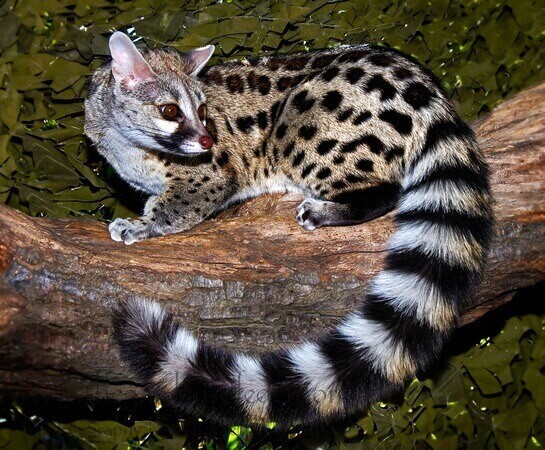
One day he took off to the other side of the lake. The previous day he had witnessed a Giant heron catching frogs in a spot not yet discovered by the ibises. On nearing the area he could make out two herons wading in the shallows, no doubt having a scrumptious morning meal. He started his descent, aiming for a clearing to the right of the herons. How it happened, he is not sure, but without warning he was attacked by a seemingly invisible animal. He heard a snapping sound and started tumbling towards the water. He landed in the shallows but soon discovered that his left leg was uselessly flopping next to the other. Fortunately the water was shallow and he could stand on one leg. The pain was unbearable. He managed a lift-off and flew back to his colony on the other side of the lake. He was still hungry but found that hunting with one leg was almost impossible. He had limited balance and his general mobility was severely impaired. Three days went by and apart from the odd cricket, he had no hunting success. He could feel his body weakening. While the hunger pains were a constant presence, the injured left leg was swollen and leaving him in agony. By the fifth day after the injury he was too weak to hop on one leg and was resigned to lying down in the low grass. By sunset he thought he saw the shadow of a genet a few meters away. His body trembled with fear. The night was closing in fast and he knew instinctively that he was exposed to danger. Danger that roamed only when the light was replaced with darkness.
He was about to doze off when he became aware of a different sound. He looked up and saw three two-legged animals walking in his direction. He had seen them before, but never this close. Strange animals they were indeed. Like himself they were walking on two legs and not all-fours like the genet and the otter, but their wings were feeble with no feathers. In fact, he had never witnessed them in flight. As they were closing in on him, he could hear his heart beating. Fear. The largest two-legger came right up to him. He made an attempt to fly, but no power resulted in no lift-off. The two-legger bent over and reached out. He made one more feeble attempt at defence, but before he knew it, Two-legger picked him out and started making funny noises. One of the other two-leggers slipped something over his head. Total darkness. From that moment onwards he could hear the two-leggers making noises, but could see nothing. He felt movement, almost as though he was flying. It relaxed him and he could feel his heartbeat slowing down. It seemed that the two-leggers were not going to eat him immediately. Sometime later the darkness was suddenly gone and another two legger with a white feathers and funny things over his eyes, looked at his injured leg. He then felt a sharp pain as Whitey stuck something in the upper part of the leg. Suddenly the darkness came again but this time it felt like falling asleep.
When he woke up it was light again and he was surrounded by other birds. Some of them he recognised, but others were not familiar. He soon realised that flying was not allowed in this place. Nobody flew, and the one turtle dove that made an attempt, crashed into some invisible thing covering the area. Thoughts of the animal that was the cause of his broken leg, rushed through his bird mind. The fear came back. Then something amazing happened. He could walk on his injured leg. He looked down and saw it covered in white feathers. The feathers were hard and he wondered if Whitey lent him some of his feathers the previous night. He was still pondering on the whys and how’s when Whitey suddenly appeared with a small pond of gazillion frogs. To his astonishment Whitey emptied the pond in front of him. He started pecking feverishly at the squiggly creatures and after some effort got one of them down his gullet. The next one was easier and by the time Whitey left the encampment, he was gulping them down one by one with the greatest of ease. Whitey seemed to be on his side and it did not seem that two-leggers exhibit similar behaviour to that of genets. He was in luck.
In the days that followed he lost all fear of the two-leggers. Every day when frog-time approached he would run up to Whitey eagerly awaiting the day’s food. While his leg felt heavy, the pain was almost gone and he walked with almost no limp. One day Whitey arrived at the encampment, picked him up and proceeded to pull off the hard feathers covering the injured leg. Initially he was bewildered but when Whitey released him from his grip, he was surprised to find his left leg light and limp-free. No more pain and no limp. Life turned out to be a pleasant surprise in the encampment.
He was at the encampment for another 5 weeks when one day Whitey picked him up and firmly held his right leg. Two other two-leggers then proceeded to put something around his right leg. When Whitey released him he felt something around his right leg but did not pay further attention. He was out of the encampment and walking around freely. The two-legger just stood there looking at him. He spread his wings and took off. Free again. He raised high above the encampment and looked down. He saw lots of other creatures – all fenced in with two-leggers looking at them through the fence. He even saw a genet in one corner and a badger in the other. He has never seen so many two-leggers in one place, but somehow his fear of them had gone. He was hungry and saw Whitey far below staring back at him. He soared gracefully down and landed next to Whitey. Looking up at him and wondering where the bucket of frogs was. His wish was answered when Whitey disappeared abruptly, just to reappear with his familiar bucket. He gulped away eagerly. Life could not be better.
In the coming weeks he found a medium-sized dam in the middle of the animal encampment where he met up with other Ibises and various water birds. He could come and go as he wanted but the daily frog bucket made the choice an easy one. He had no incentive to leave. His appetite for adventure was quelled for good. Sometimes he would take off and fly in no specific direction, but he always returned. Always back to the daily portion of frogs that Whitey would deliver without fail. He stayed at Pretoria Zoo for many summers and winters. He had no reason to leave.
Then one day Whitey did not show up with his green frog bucket. This concerned him greatly and since he had over the years stopped hunting for food, his attempts at catching insects and worms were lame to say the least. He found it almost impossible to catch frogs from the pond, and fish, well that was never his strong point. That evening he struggled sleeping with the ever-present hunger pangs keeping him awake. The following day arrived and again Whitey never came. By the fifth day he realised that his frog friend was gone and no two-legger was there to take his place. He would have to survive like in the old days. He still used the zoo as his base, but every morning he would travel to a marshy lake nearby where food was in abundance. This would soon become his new ritual. Sleep at the zoo between countless different bird species and where he was safe from nocturnal night-dwellers like genets and mongoose; and then leave at daybreak for the marsh where a vast variety of edible creatures were on the menu. Soon Whitey was forgotten and life back to normal. During this time he courted another ibis and managed to raise the young to adulthood. When the latter spread his wings, and took off on his first exploratory mission, he could not help thinking back to a time when he had dreams of exploring other parts of the world. His thoughts took him back to his parents and the dam where he was born. Perhaps one day, he could return. At first a return trip to his birthplace was not a serious consideration, but his mind was more or less made up, when a number of massive yellow monsters appeared on the side of the marsh. They sounded aggressive and loud, but were too slow to catch him. They were pushing soil into the marsh – what for, he did not understand. The space where frogs, insect and other water creatures could habituate, were decreasing at a rapid pace. Then one day, there was no more marsh. The noisy marsh sounds of crickets, frogs and of course birds were suddenly gone. The silence was eerie. His food source was replaced by hard soil and soon other monsters came and built what looked to him like tall rocks, on top what used to be his marshland. He knew then that he had to leave.
It took him two more days to make a final decision and one morning he rose early and took off, flying high in search of a wind current that would take him south. He instinctively knew which direction pointed to his origins. The journey took him longer than before but by day forty five, some familiar landmarks jarred his memory back to a time when he was stronger and with more energy. A few days before two other ibises joined him in flight. They were younger than him but allowed him to lead the way. Flying in a V-formation for optimal slipstreaming efficiency and with the aid of a strong current they effortlessly achieved speeds of over 50 km/h.
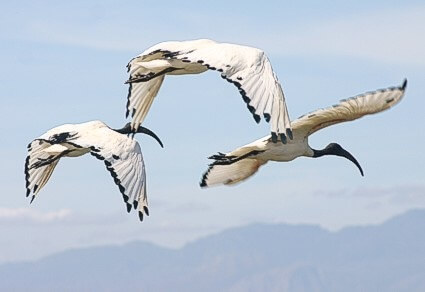
He instinctively knew this was the last day of the journey and this thought gave him additional energy. He felt young again and noticed his two compatriots straining themselves to keep up with him. Then as from nowhere, he saw the dam. It has not changed a bit. He saw some two-leggers on the water in canoes and remembered them paddling on the dam during his teenage years. To the one side of the dam, he noticed the flock of Sacred Ibises wading in the shallows. A tingle of excitement stirred in him as he started gliding downwards to the crowd. For once he wished he could shout like the Hadeda, but the only sound of joy coming from his throat was a raspy croak that only managed to amuse his two companions. Lower and lower they glided. He was close enough to see the tree where he was born. Exitement. Then it happened. An invisible hand grabbed him and jarred him to a sudden standstill. As he tumbled to the ground, he noticed the wires for the first time and saw his companions crashing into them with such force that the ones neck snapped and the other was knocked unconscious. He landed with a thud on the ground next to the dam. He was alive, but somehow could not move. His one wing flapped uncontrollably. Out of the corner of his eye he saw the two-legger in the canoe paddling towards him. He saw him get out and approach him. When the two-legger picked him up, he felt safe and at peace. He felt the darkness coming over him in the same way it did when they fixed his leg at the zoo. Then he was gone. The date was 17 June 2014.
The man noticed the ring around the bird’s leg. It read “Contact Pretoria ZOO, Track number: 8-01488.
------------------------------------------
Interesting facts on the Sacred Ibis
- Spesies : Threskionis aethiopicus
- Historical connection to Egypt :
- The bird was well known in ancient Egypt and is depicted in numerous ancient Egyptian wall murals and sculptures
- The Ibis was known to represent the god Thoth, god of wisdom and knowledge and mummified specimens were found at ancient Egyptian burial sites.
- It was of practical use to villagers as it helps in keeping fish ponds clear of snails that were infested by liver parasites.
- Today, the Sacred ibis is extinct throughout Egypt because of swamp drainage.
- Regarded as a waterfowl - finds food in shallow water and mud.
- Diet : grasshoppers, locusts, crickets, frogs, worms, molluscs, crustaceans and fish.
- The head and neck are featherless but covered in a black scaly skin.
- They are generally silent other than making a harsh croaking sound.
- They build colonies of up to 300, along with other species such as spoonbills.
- Both parents attend a clutch of 2-4 eggs for about 3 weeks and then take turns feeding the nestlings. The chicks only leave the nest at 15-21 days old but continue to be fed until they grow flight feathers – This happens when they are about 35- 48 days old.
- Breeding success is however extremely low, with the majority of the chicks not making it to adulthood.
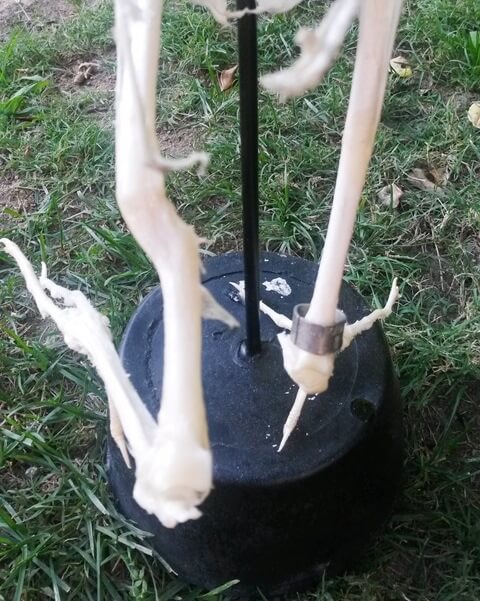
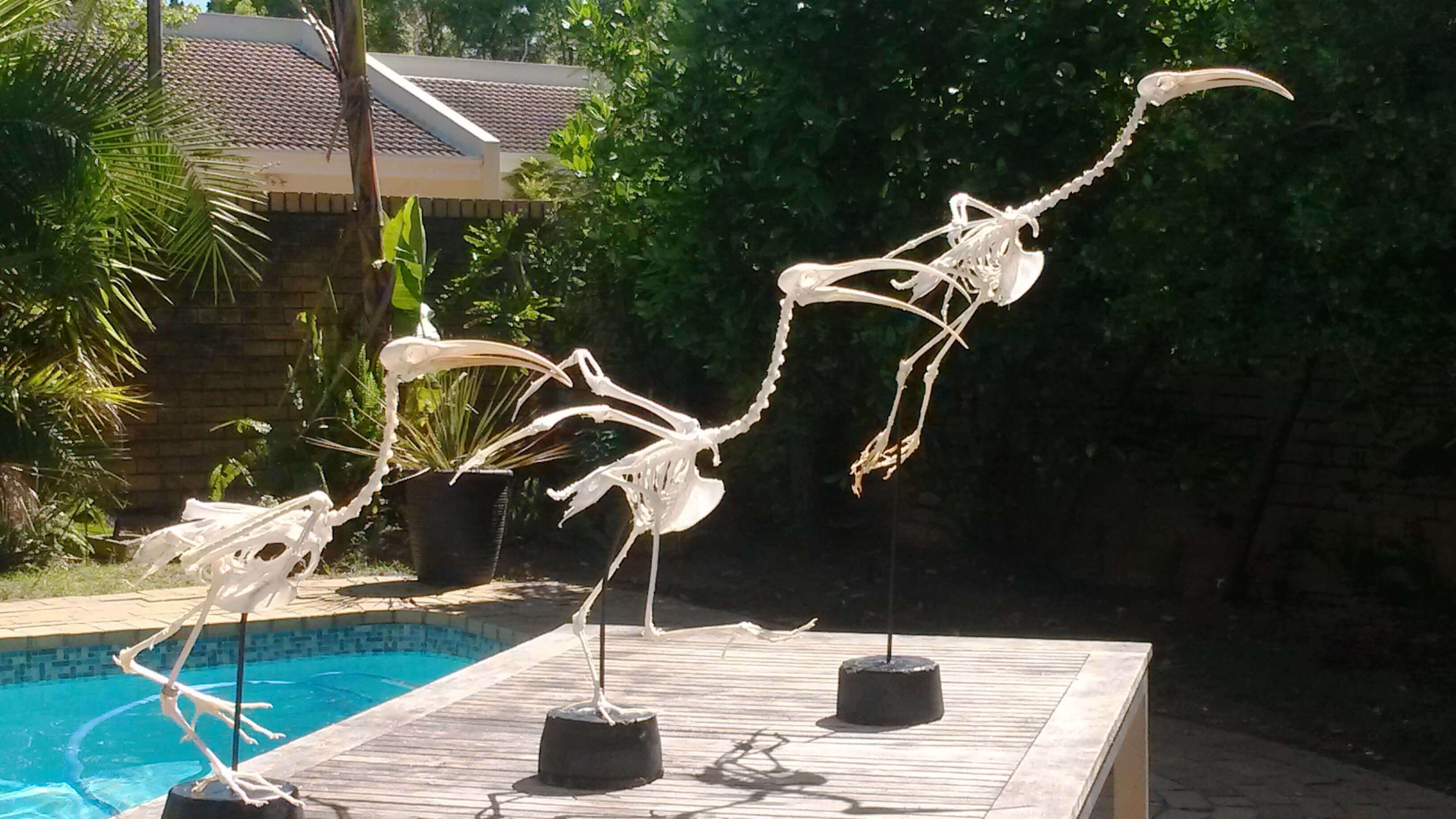
The Sacred ibis was found with a broken leg and subsequently rehabilitated by Pretoria zoo. The bone regrowth scar on the left leg is clearly visible. He was ringed in 2004 and released a few months later. Apparantly he regularly visited the zoo, but eventually dissappeared. Exactly ten years after he was ringed and 1500km from Pretoria zoo, the bird flew into high voltage power lines over a dam near Stellenbosch, together with two other birds. I happened to paddle on the dam when the incident happened. Two of birds died on impact; the third one died 3 hours later. Their skeletons may be viewed at Butterfly World.


